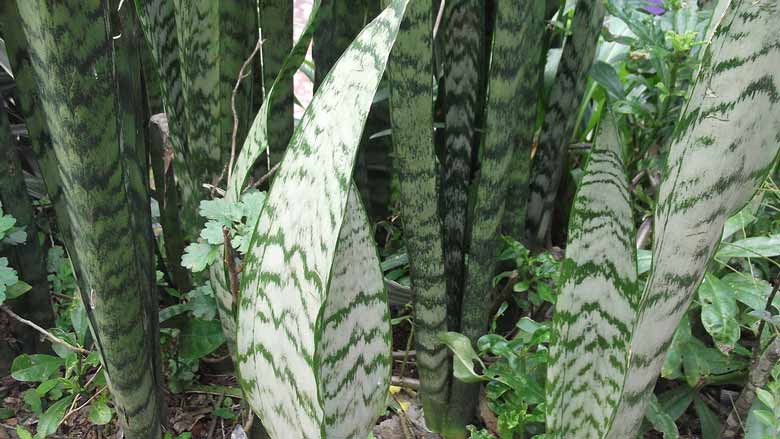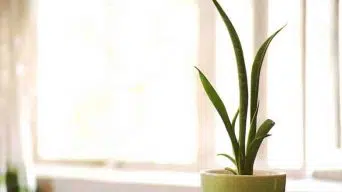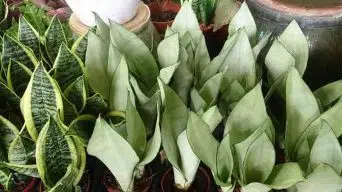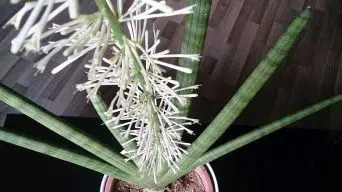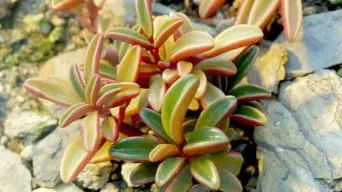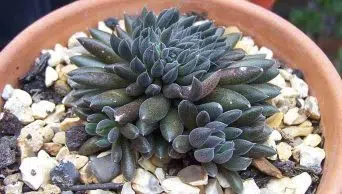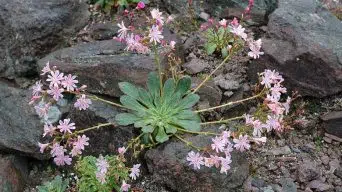Succulents are among the most popular plants, and Sansevieria zeylanica is no exception.
It’s very easy to grow and propagate, making it an excellent choice for new gardeners.
Gardening enthusiasts like this plant because of its simplicity, low maintenance, elegance, and durability.
Although succulent plants are known for being drought tolerant, they also need attention to detail regarding watering, sunlight exposure, and soil conditions.
Here’s everything you need to know about taking care of and propagating Sansevieria zeylanica succulents.
Sansevieria Zeylanica Overview.
| Family: | Asparagaceae |
| Genus: | Sansevieria |
| Botanical Name: | Sansevieria zeylanica (L.) Willd |
| Synonyms: | Aloe Hyacinthoides var. zeylanica, Sansevieria roxburghiana, Dracaena roxburghiana |
| Common Names: | Ceylon Bowstring Hemp, Devil’s Tongue, Snake Plant, Zeylanica Snake Plant, Mother-in-Law’s Tongue |
| Origin: | Southeast Asia and West Africa |
| USDA Hardiness Zones: | 9 – 11 |
| Size: | Up to 2.5 feet (76 cm) long and 2 inches (5 cm) wide. |
| Sun Exposure: | Full sun to partial shade |
| Water Needs: | Water thoroughly but infrequently |
| Soil Type: | Well-draining soil |
| Temperature: | 68°-80° ((20-27°C) during the day and 50-65° Fahrenheit (10-18°C) at night |
| Humidity Levels: | 40% |
Sansevieria zeylanica, commonly known as bowstring hemp, is an evergreen, tropical plant from the Asparagaceae family that is endemic to Southeast Asia and West Africa.
It belongs to the Sansevieria genus and is a close relative of Sansevieria Trifasciata, often known as the mother-in-law’s tongue or snake plant.
The leaves of Sansevieria zeylanica, a stemless flowering plant with long, sword-shaped leaves that develop from a rhizomatous rootstock.
The dark green leaves of this snake plant species have white waves of horizontal streaks across their surface and can grow up to 2.5 feet tall and up to 2 inches wide.
Sansevieria Zeylanica Plant Care Guide
Sansevieria zeylanica care is very simple because this succulent plant can handle little maintenance.
Here you can find the essential information about caring for Sansevieria zeylanica.
Sun Exposure & Light Requirements
The Sansevieria zeylanica is a succulent that grows well in bright light but not in direct sunlight. Too much sun can scorch the leaves.
A location that receives bright indirect light but is out of direct sunlight is ideal.
If you are growing the Sansevieria zeylanica plant indoors, place it near a west or east-facing window or any location that receives bright light.
If you are growing S. zeylanica outdoors, place it in a sunny spot where it will receive bright indirect sunlight or morning sun for most of the day.
Avoid intense direct sunlight, especially in the middle of the day when the sun is at its strongest.
Watering Requirements
Bowstring hemp plants do not need a lot of water, making them perfect for those who often forget to water their plants. They only need to be watered when the soil feels dry.
However, they will likely need to be watered more often during the summer as the heat causes the soil to dry out more quickly. During the winter months, you should water them less often.
During the growing season (summer), watering is usually fine once a week.
Ensure that the soil becomes completely dry before you water your plant again to prevent root rot and other diseases.
During their dormant phase (winter), only water this snake plant every two to three weeks.
Soil Requirements
The Sansevieria zeylanica, like most snake plant types, does best in light and sandy soil.
A potting mix that drains well is essential, as this plant doesn’t like wet feet.
A cactus mix with added perlite would be a good mix to use.
If you want to make your own potting mix, combine one potting soil, one perlite, and one coarse sand.
This mix will provide the Sansevieria plants with good drainage and aeration.
Temperature and Humidity
As a succulent, bowstring hemp requires little water and does well in dry environments.
Letting the soil completely dry out between waterings is possible without harming this Sansevieria plant. This makes the plant an ideal choice for low-maintenance care.
The recommended temperature range for this succulent is 68° – 80° Fahrenheit (20 – 27°C) during the day and 50 – 65° Fahrenheit (10 – 18°C) at night.
This Sansevieria plant also does well in dry environments, with a 40% humidity level.
Fertilizing
Sansevieria zeylanica does not need to be fertilized often. It would be best if you only fertilized it during the growing season, typically in the spring and summer.
You can use a balanced 10-10-10 fertilizer or a 20-20-20 fertilizer.
Apply the fertilizer at half the recommended strength and water it into the soil.
Be cautious not to overfertilize, as this can damage this snake plant.
Potting and Repotting
Sansevieria zeylanica should be repotted every 2-3 years.
Use pots with enough holes on the bottom to ensure good drainage and airflow. Also, make sure to use a potting mix with excellent drainage properties.
Use a pot that is only slightly larger than the current pot. Amend the soil with some fresh potting mix before repotting.
Be careful not to damage the roots when repotting.
Bowstring hemp can be grown in a large pot, container, or ground.
When potting Sansevieria plants, using a terracotta pot, clay pot, or something with good drainage is best.
A plastic pot would retain too much water and cause severe root rot.
Early spring is the best time to transplant or move a Sansevieria zeylanica snake plant. After the threat of frost has passed and when night temperatures are consistently above 50 degrees F.
Pruning
Sansevieria zeylanica plants don’t require much pruning to stay healthy. Still, if you choose to prune them, you should do so during their growing season.
Remove any damaged or dead leaves, and cut off any dead rhizome sections (the thick stem-like structure that the leaves grow from). This helps the snake plant conserve energy and helps prevent pests.
There is no need to remove healthy growth as it can strengthen future growth.
If you wish to remove only part of the plant, you should cut just below a leaf node (the place where another leaf emerges).
The leaves are stiff and sharp, so be careful not to harm yourself.
If the growing point is damaged or removed, Sansevieria zeylanica will produce new growth from one of its side bulbs.
Pests and Diseases
Sansevieria zeylanica is a hardy plant and does not get many diseases or pests.
However, a few pests and diseases can affect the Sansevieria.
Here is a list of some pests and diseases that may affect your Sansevieria zeylanica.
Red Spider Mite
This pest is tiny but can cause severe damage to any plant.
The red spider mite can cause yellow and brown spots and distort the plant’s leaves.
To eliminate this pest, you should spray your Sansevieria zeylanica with a forceful stream of water.
Mealybugs
This is another type of insect that can damage Sansevieria zeylanica.
You will be able to see mealybugs as small, white insects on the stem or leaves of your snake plant.
To get rid of mealybugs, you can use neem oil, insecticidal soap, or a mixture of alcohol and dishwashing liquid.
Snails
Snails can be another pest that can damage your Sansevieria plant.
They are slow-moving, but you will notice holes in the plant’s leaves caused by their feeding behavior.
You can place copper tape around the pot or put out a trap using beer or grapefruit halves to get rid of snails.
Fungal Diseases
Fungal diseases are a common problem for succulent plants.
The most common fungal disease that affects Sansevieria plants is powdery mildew. This disease will cause a white powder to form on the leaves and stems of your plant.
You can use a fungicide or baking soda and water mixture to treat powdery mildew.
Root Rot
Root rot is a disease that can affect any plant, and it will cause the roots to rot. This disease can be fatal to your Sansevieria plants.
To prevent root rot, you should ensure that the potting mix is well-drained and that you do not overwater your plant.
Crown Rot
Crown rot is another disease that can affect Sansevieria plants, and it will cause the leaves to turn black and the stem to rot. This disease can be fatal to your plant.
To prevent crown rot, you should ensure that the potting mix is well-drained and that you do not overwater your plant.
How to Care for Sansevieria Zeylanica Plant in Winter
Sansevieria zeylanica plant care during winter is critical to keep your succulent healthy.
To keep your Sansevieria zeylanica happy during winter, you will need to do the following:
- Keep your bowstring hemp in a sunny location with indirect sunlight.
- Keep the temperature around 65 degrees Fahrenheit during the day and 55 degrees Fahrenheit at night.
- Keep your Sansevieria plant away from drafts and heat vents.
- Reduce watering during winter to once every two weeks.
- Refrain from fertilizing your Sansevieria during winter.
- Bring your succulents inside if the temperature falls below 40°F (5°C).
If you follow these tips, your Sansevieria zeylanica will stay healthy and happy during winter!
How To Propagate Sansevieria Zeylanica (Snake Plant)
Sansevieria zeylanica is a succulent plant easily propagated by leaf cuttings or division.
Here’s how:
Sansevieria Zeylanica Propagation by Leaf Cutting
To propagate a Sansevieria zeylanica by leaf cuttings:
- Cut a healthy leaf from the Sansevieria zeylanica succulent plant with sharp scissors. Make sure to cut the leaf as close to the bottom as possible.
- Cut the leaf into 2-3 inch long pieces.
- Let the cuttings dry for a day or two before planting.
- Plant the Sansevieria zeylanica cuttings in moist cacti/succulent potting soil.
- Keep the cuttings moist and out of direct sun for about two weeks to allow the roots to grow well before planting them in their permanent location.
- Transplant the S. zeylanica leaf cuttings into your favorite succulent container or garden bed.
Sansevieria Zeylanica Propagation by Division
To propagate a Sansevieria zeylanica by division:
- Dig up the succulent plant with a shovel and divide it into two or more sections with a sharp knife.
- Cut off any dead or damaged leaves.
- Replant the divisions in fresh potting soil and water well.
- Place in a sunny spot and allow the soil to dry before watering.
- Water sparingly until new growth appears, which signals that roots have developed.
- Transplant the succulent into a larger pot when it has grown enough.
Final Thoughts
Succulents make great houseplants because they are low maintenance and easy to propagate.
If you want a plant to add color and life to your home, consider giving a Snake plant Zeylanica a try.
The Sansevieria zeylanica is an excellent option because it is beautiful, durable, and easy to care for.
It is a stunning houseplant that would make an excellent addition to any home and garden.

